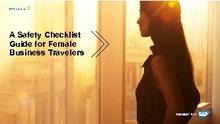How Your Mobile Phone Helps Keep You Safe When Traveling
In this four-part blog series, we’ve acknowledged the fact that female business travelers face greater risks while on the road, compared to men. Examples include assault, sexual harassment, and personal and identity theft. We’ve also covered the importance of knowing how to get help when we feel threatened or are in physical danger due to a disease outbreak, political unrest, a terrorist event, or a natural disaster. If we work for a company with duty of care policies, we can check that these policies address the unique safety needs of female travelers. If we’re solopreneurs responsible for our own insurance and personal protection, we have resources at our fingertips to make sure we have the critical safety basics covered.
In the past decade especially, innovations in mobile technology have evolved making it possible for companies, travel insurance providers, and mobile phone manufacturers to offer apps and feature functionality to help protect our safety. We can now initiate a 911 or SOS alert within seconds, no matter where we are in the world. Voice activated translation apps can help us communicate critical words and phrases in countries where we don’t speak the language. Especially if we are traveling alone, our mobile devices can offer a powerful, real-time connection to needed resources. A great reason to keep our phones charged at all times and always remembering to pack phone chargers and a travel plug adapter if we’re traveling internationally.
Customize your device for safety
Ahead of any business trip, initiating safety capabilities and protection on your mobile phone is a smart thing to do. Here are some tips to get you started.
- Sign up for alerts and connect to an embassy. For international travel, know the location of the closest U.S. embassy or consulate, and check the option to enroll your trip so the embassy can send you mobile alerts in the event of an emergency.
- Consider installing Google Translate or Trip Lingo. Both are voice translating apps that can help you in emergencies when language barriers pose a problem. You can learn words like ‘Help’, ‘Emergency’, and ‘No’ in 103 languages.
- Research TripWhistle. You can dial local emergency police, fire, and ambulance phone numbers anywhere in the world with a single touch, immediately providing critical information to emergency responders.
Protect yourself and your information if your mobile phone is lost or stolen
These are all actions you can initiate from within your phone, ahead of your travel.
- Lock your mobile device with a strong password or use biometric protection. This is the first line of defense against stolen phones.
- Update your software. Make sure your software is running the latest patch because many include fixes for security bugs.
- Banish unused apps. Delete any old apps you’re not using anymore because the data they store about you can also track your location—and can be used by criminals.
- Set up a PIN. Under ‘settings’, create a PIN, which sets up data encryption on newer Apple models and ensures your data is safe from unwelcome eyes.
- Turn off Wi-Fi. When you’re not using it, turn it off so it doesn’t automatically sign you onto the next free Wi-Fi which could possibly be unsafe.
- Turn on ‘Find My Phone’ and remote wiping. You’ll have to enable these features before you travel, so they can work for you if your phone is lost or stolen.
- Turn off location tracking. Even though this gives you access to location features, it’s also like a trail of breadcrumbs right to you—in the wrong hands.
For companies looking to protect their female travelers through mobile technology, SAP Concur offers cloud-based software applications called Concur Locate, TripIt and TripIt Pro. The TripIt apps show safety scores for neighborhoods, lodging, and restaurants around the world, including categories women care about: physical harm, women’s safety, health and medical, theft—and embassy information for more than 180 countries. Speaking of country safety, this 2017 Forbes article lists the 10 most dangerous places in the world for women to travel. Good for all of us to know.
October and November are historically the busiest months of the year for female business travel. If you’ve got a trip planned in the weeks ahead, and even if you don’t, adding mobile security and resource options to your devices is a great way to take very good care of yourself.
See also:
Part 1: Why is Business Travel Safety Different for Women?
Part 2: Are Companies Doing What They Can to Safeguard Female Travelers?
Part 3: How Women Can Create Their Own Safe Business Travel Experience


